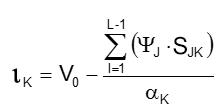SFEcon’s structure of variables offers a great many choices for an interest rate formulation. Our ambition for Model 0, being the establishment of the most primitive and normative view of economic adjustment, dictates that the simplest and most straightforward option be chosen. It will reference value rather than money. Model 0’s interest rates -iK for the economies K are creatures of K’s technology, its current state, and the global economy’s current commodity values YJ.
The most elementary understanding of a return rate presumes that the value of the industrial sectors’ assets has been diverted from the household sectors’ immediate consumption in order to create continuing flows of value that are greater than the value of what is expended in industrial production.
Model 0 summarizes the asset valuations of an economy K’s industrial sectors (organized in column J=0 of economy K’s physical state variables) in a variable named aK. Indexing the first household sector in the matrix structure as L (for labor/leisure), the industrial sectors’ row indexes would range from 1 to L-1. Asset valuation is then given by:

As with any physical stock, value is propelled by its turnover fraction V0/yr. V0 is a constant 1/yr. because financial variables such as the interest rate -iK or the investment term TK are always computed in reference to asset turnover that occurs per annum.
The value of assets continually being extinguished V0
·
aK G/yr. produces a suite of
outputs YJK having a composite value that exceeds cost of sales
V0
·
aK
by profits -iK
·
aK. These profits must, of course, be
earned in respect to the value of all production that is currently available for use in creating the
next generation of goods, including the values of those products remaining idle on the markets. Thus we
equate the value of assets being expended, plus the value of profits to be required of those expenditures,
with the value of products currently in supply in order to determine the current interest rate
-iK:

Since current commodity values YJ and supply rates SJK are known from the model’s current state, this equation completely determines iK:

Here we can see the presence of goods on the market (SJK > YJK) operating to raise interest rates (i.e. increase -iK's negative magnitude).